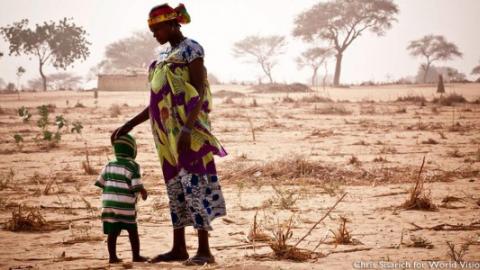
Overview
Overview:
Across West Africa World Vision is hard at work helping children and their communities cope with the devastating effects of cyclical drought. This year more than 19 million people living in the Sub-Saharan Sahel belt faced hunger, acute malnutrition and possible starvation. Aid agencies, including World Vision, responded by launching emergency appeals and ramping up aid work focused on feeding the most vulnerable, especially children and young or expectant mothers. USD$36m was raised by World Vision globally. It provided pregnant mothers and starving children with emergency food rations, helped poor villages create kitchen gardens, re-stock empty grain banks and met the needs of refugees who fled conflict in Mali. A host of other resilience building programmes are also being funded.
During the worst of the hunger season millions of people living in Mali, Niger, Mauritania, Senegal and Chad were affected, leading to a region-wide World Vision humanitarian response targeted at some 1.1. million people. At the height of this challenge a coup and an insurgency in Mali led to tens of thousands fleeing within the country and over the border into Niger. World Vision has also been giving aid and schooling to refugees on the border.
Background to the crisis:
Millions of people live on the edge in West Africa thanks to a cocktail of problems. Climate change is leading to ever more frequent droughts pushing people who already live on the edge over it. This year’s rains have been good and there may be bumper harvests in some areas but droughts are now more frequent, occurring every couple of years. World Vision is strengthening its focus on building resilience – giving communities the tools, knowledge and support to beat the environmental challenges they face.
We are also encouraging wealthy governments not only to give more money to West Africa but to focus that money on building resilience programmes that will bring long-term lasting change. The solution is to move away from funding emergency aid to helping communities build stronger livelihoods to face down poor rains and arid conditions.
West Africa has also been destabilised by the effects of conflict. Armed groups who fled the Arab Spring uprising in Libya have moved into West Africa. In Mali, a coup overthrew the elected government and large areas of the north are now under the control of hardline rebels.
World Vision has been continuously working to meet the needs of Malians despite these challenges and has been advocating with the United Nations, NGOs and other partners to prioritise the protection of civilians, particularly children, through coordinated humanitarian efforts.
Locusts and meningitis outbreaks have also threatened populations, and the decline in food stocks and food price spikes have pushed millions to the edge.
In 2012, World Vision worked with Save the Children to better understand the dynamics behind the situation in West Africa producing the ‘Ending the Everyday Emergency’ Report. This report is designed to inform World Vision’s future programme design and help governments better understand what is keeping millions in poverty. It recommends actions that promote resiliency among the most vulnerable, such as reducing child malnutrition, harnessing small-scale agriculture, investing in social safety nets and services, and bringing governments, development agencies and others together to work much more collaboratively on plans to tackle the root causes of the food crisis.